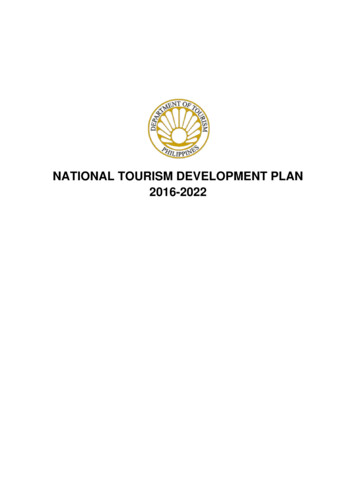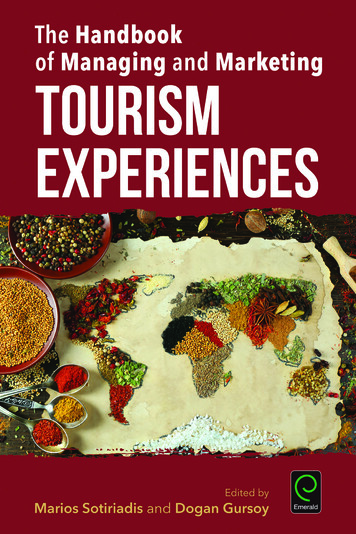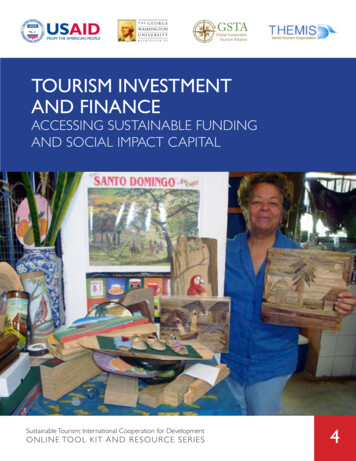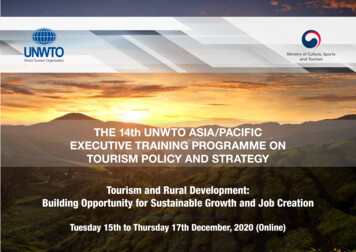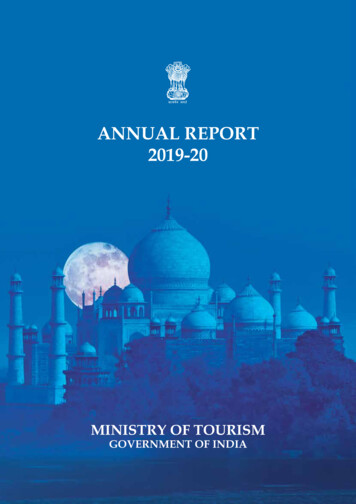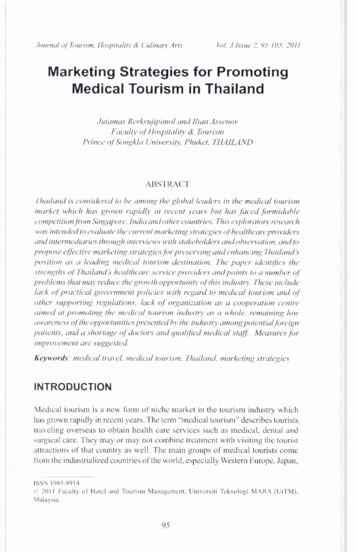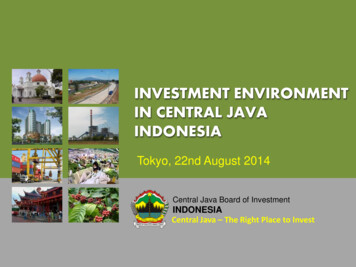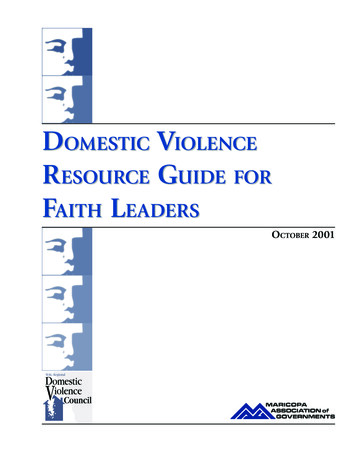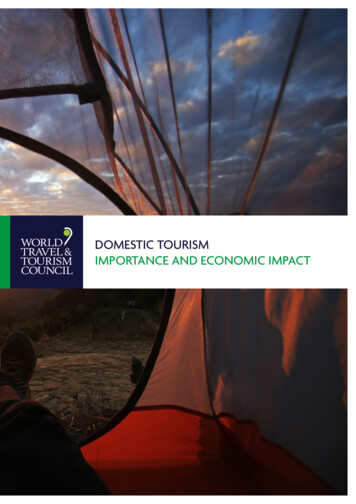
Transcription
DOMESTIC TOURISMIMPORTANCE AND ECONOMIC IMPACT
HIGHLIGHTSCONTENTSHighlights01Introduction12The importance of domestic spending12.1. Absolute size of Travel & Tourism’s Domestic Spending12.2 Reliance on domestic tourism33Growth trends in domestic tourism spending54Policies to raise the contribution of domestic tourism55Appendix7HIGHLIGHTS Domestic tourism is the key driver of the tourism sector globally,accounting for 73% of total Travel & Tourism spending in 2017. Governments use domestic tourism as a tool to eliminate localpoverty, generate employment and economic growth, upgradeinfrastructure and alleviate pressure from overcrowding through, forinstance, discretionary pricing policies and the provision of non-wagetourism benefits. Domestic travel helps address seasonality within regions, whilealso dispersing tourists to less visited rural areas, which tend to beoverlooked by foreign visitors. China has been extremely successful in fostering domestic tourism,outperforming all other countries in domestic spending growththanks to its growing middle-class and government’s support. Chinais now the leading domestic tourism market, up from 4th position in2008, having accounted for 62% of absolute growth in this period. While China leads in absolute domestic spending growth, manydeveloping countries have shown significant growth in Travel &Tourism domestic spending, as residents with rising disposableincome begin to explore their countries.For more information, please contact:ROCHELLE TURNER Research Directorrochelle.turner@wttc.orgDOMESTIC TOURISM – IMPORTANCE AND ECONOMIC IMPACT
1 INTRODUCTION2 THE IMPORTANCE OF DOMESTIC SPENDING1 INTRODUCTIONcost carriers in second- and third-tier cities. This has improved transportation connectivity and reinforced tourismdevelopment in less visited areas. China is expected to remain the leader in domestic tourism, continuing to widenits lead with the USA by 2028.While countries often tend to focus on international tourism due to therevenue earned through exports, domestic tourism remains the leadingform of tourism, representing an important tool for regional economicgrowth and development.Germany ranked third in domestic spending in 2017 with US 340 billion, nearly double the amount of Indiaand Japan, which came fourth and fifth with US 186 and US 183 billion respectively. It is worth noting the rapiddevelopment of the domestic Travel & Tourism market in India, which grew by US 83 billion and rose from theeighth to the fourth largest domestic market between 2008 and 2017. Unsurprisingly, the largest developedcountries dominate the top spots in terms of absolute size of domestic spending.With over 50% of the global population now categorised as “middle class”or “rich”, more and more people can afford to travel. Research suggeststhat domestic tourism demand picks up at an income level of aboutUS 35,000, while international travel takes off at around US 50,0001.An increasing number of households in emerging economies, which areapproaching or have already reached these thresholds, including in Chinaand India, are likely to contribute to sustained growth in domestic travelspending. In effect, in the next ten years an additional 65 million Chineseand 9 million Indians will enter the middle class.Chart 1: Countries’ positions in domestic visitor spending (2008 and 2017)(Travel & Tourism Domestic Spending, in 2017 US bn real prices)2008 RANKUsing the World Travel & Tourism Council’s (WTTC) annual economicimpact data, this position paper assesses the importance of domestictravel to 185 countries, considers the trends driving this phenomenon andprovides policy recommendations for the continued growth of domestictravel in the global economy.2 THE IMPORTANCE OF DOMESTIC SPENDING2.1 Absolute size of Travel & Tourism’s domestic spendingIn 2017, domestic tourism represented 73% of the total global tourism spend(US 3,971 billion). While there are significant variations between countries,domestic contributions to Travel & Tourism reached 94% in Brazil and 87%in India, Germany, China and Argentina; with China accounting for 62% ofglobal absolute growth in domestic spending over the past ten years.This growth has enabled China to climb from fourth position in 2008 tothe top spot in 2017, overtaking the USA to become the largest domestictravel market in the world. China’s domestic spending reached US 841billion in 2017, followed by the USA with US 803 billion. Jointly, these twocountries account for over 40% of world’s total domestic Travel & Tourismspending.Over the last decade, the Chinese government has been a staunchsupporter of domestic tourism, investing in the development of a railnetwork and air infrastructure to accommodate the expansion of low-11See Goldman Sachs ladder of achs-on-what-the-world-wants-2013-10?IR T WORLD TRAVEL & TOURISM COUNCILDOMESTIC TRAVELREPRESENTS 73% OFTHE TOTAL TOURISMSPEND GLOBALLYCHINA AND THE USAJOINTLY ACCOUNTFOR OVER 40%OF THE WORLD’STOTAL DOMESTICSPENDING2017 0Mexico93.910Brazil99.9DOMESTIC TOURISM – IMPORTANCE AND ECONOMIC IMPACT 2
2 THE IMPORTANCE OF DOMESTIC SPENDINGBRAZIL LEADS THEPACK AMONGST THEMAJOR ECONOMIESWITH 94% OF ITST&T SPENDINGCOMING FROMDOMESTIC TOURISTS2.2 Reliance on domestic tourismDomestic travel is the main driving force of the Travel & Tourismin major economies (See chart 2). In fact, in 22 countries of the 31countries analysed2, domestic tourism accounted for at least 50% ofthe total Travel & Tourism spending, with Brazil ranking first with 94%of spending coming from domestic tourists. Brazil is followed by India,Germany, China and Argentina each with 87%. Japan, Mexico, the UKand the US also enjoyed significant levels of domestic spending – all at80% or more of Travel & Tourism’s internal spending.Strong domestic tourism in most of these countries is driven by agrowing or sizeable middle-class population, an increase in spendingpower among domestic consumers, the sheer size of the countries,governments’ initiatives in promoting new locations, and strong orimproving transportation infrastructure and economic links betweendifferent internal regions. For instance, China has built an average ofeight new airports every year since 20133, and rapidly developed itshigh-speed rail network over the last 15 years which has opened-uppreviously remote places to domestic tourists. In India, the governmentplans to build 100 new airports with a budget of US 60bn over thenext ten to 15 years to accommodate and stimulate the demand fordomestic travel4.Chart 2: Reliance on Domestic Tourism Across the Major Countries, anMexicoUKUSACanadaAustraliaItalySouth KoreaRussiaFrancePeruIndonesiaColombiaSaudi ArabiaSouth ngaporeUAEJamaicaThailand0%10%20%30%40%Domestic as % share of Travel & Tourism spendingMigration levels and tourism demand are inextricably connected.Countries with high levels of first and second-generation foreignimmigrants tend to have a larger share of domestic travel spending5. Thismay be the result of immigrants seeking to discover their new countryand explore new cities and regions with friends and relatives when theycome from abroad. Similarly, high levels of domestic migration (migrationfrom one region in the country to another) also contributes to higherlevels of domestic tourism as relatives regularly visit each other6.Low levels of passport ownership among the population, partly due todiscretionary income, further fuels the growth of domestic tourism. Ineffect, only 6% of the population in India and 9% in China have beenissued with a passport to date. In the USA only 42% of the population hasa passport. While this represents a significant increase from a 27% sharein 2007, it still lags far behind other developed countries, particularly inEurope.2 Our analysis includes G20 countries and WTTC’s selection of additional major economies3 World Economic Forum, the Civil Aviation Administration of China4 https://www.routesonline.com/5 t-inflows.htm6 C. Massidda and R. Piras: Does Internal Migration Affect Italian Domestic Tourism? A Panel DataAnalysis; Tourism Economics, June 20153 WORLD TRAVEL & TOURISM COUNCIL50%60%70%80%90%100%International as % share of Travel & Tourism spendingThe ten countries with the highest reliance on domestic tourism to drive the performance of their Travel &Tourism sector are emerging economies. These nations often struggle to attract international tourists due to visarestrictions, geopolitical or security risks, lack of quality infrastructure and poor air connectivity. This is the casefor Papua New Guinea, Guinea, Libya, Bangladesh and Algeria, for whom domestic spending accounted for over97% of internal Travel & Tourism’s consumption in 2017.Table 1: Top 10 countries with the strongest reliance on domestic tourismRankDomestic as % share of internal spendingPapua New Guinea199.8Democratic Republic of 1094.3DOMESTIC TOURISM – IMPORTANCE AND ECONOMIC IMPACT 4
3 GROWTH TRENDS IN DOMESTIC TOURISM SPENDINGTHAILAND IS ONEOF THE COUNTRIESWITH THE LOWESTDEPENDENCE ONDOMESTIC TOURISMThe reliance on domestic tourism also varies significantly acrosscontinents, particularly in Asia. While India, China and the Philippinesstrongly rely on domestic tourism, Vietnam, Malaysia, and Thailand sit atthe other end of the spectrum. Only 21% of Travel & Tourism spendingin Thailand is attributed to domestic visitors with the remaining 79%coming from international tourists. Still, most of these countries attracta significant number of international visitors, not only because of theirwell-developed air infrastructure and availability of low-cost airlinesbut also due to good rail, land or sea connectivity with other countries.Yet in certain cases, accommodation has been developed to satisfyinternational travellers’ preferences and budgets, in turn limiting lowercost options and serving as a brake in the expansion of domestic travel.3 GROWTH TRENDS IN DOMESTIC TOURISMSPENDINGThe rapid growth in middle class income households in emerging marketshas been an important driver of domestic Travel & Tourism, notably in theAsia-Pacific region. While there is a positive correlation between the growthof GDP per capita and domestic spending; the wide range in performancefrom country to country reflects the varying stages of maturity of thetourism sector, differing income levels, infrastructure development and thegeopolitical and economic landscape in each of the countries.The fastest-growing countries in terms of GDP per capita and domesticspending are in Asia-Pacific. Unsurprisingly, China took first position, witha 9.2% average annual growth in GDP per capita and a remarkable 16.8%growth in domestic spending over the past decade. The Philippines andMalaysia also witnessed strong annual growth in both GDP per capita anddomestic spending.STRONG ANNUALGROWTH IN TRAVEL &TOURISM INVESTMENTIN SELECT AFRICANCOUNTRIES HAS BEENASSOCIATED WITH HIGHGROWTH IN DOMESTICTRAVEL SPENDING5 WORLD TRAVEL & TOURISM COUNCILSeveral African countries have also experienced a strong increase in bothGDP per capita and domestic spending during 2008-17, notably Rwanda,Mozambique, Tanzania and the Ivory Coast. Rwanda’s average 14% annualgrowth in domestic spending over each of the last ten years has beenenabled by the prioritisation of sustainable tourism, with real and tangibleimpacts both in terms of community development and conservation.While in many developing countries domestic tourism tends to be smallin absolute terms, the rate of growth of Travel & Tourism domesticspending is high.To support and sustain the strong growth in the sector’s demand, capitalinvestment in Travel & Tourism infrastructure is essential. Examining therelationship between capital investment growth and domestic spendinggrowth, a few African countries appear as the standout performers. Forinstance, Mozambique’s 15.8% average annual growth in capital investment4 POLICIES TO RAISE THE CONTRIBUTION OF DOMESTIC TOURISMbetween 2008-17 is associated with 11.6% annual growth in domestic travel spending, while Mali’s 9.1% annual growthin capital investment is linked to 11.5% growth in domestic travel.Several ASEAN nations, including Laos, Myanmar and Indonesia, saw a significant growth in Travel & Tourism capitalinvestment; however, growth in domestic travel was not as robust. Weaker growth in domestic spending maybe associated with lower discretionary income levels - which limit residents' ability to travel - as well as a lack ofsupportive government policies in some of these countries, and a need for more affordable tourism products toserve this market.4 POLICIES TO RAISE THE CONTRIBUTION OF DOMESTIC TOURISMDomestic travel supports and develops local and national pride, provides a rationale for an upgrading ofinfrastructure, disperses visitors geographically across regions, smooths seasonality and creates employmentopportunities. It can play an important role in improving the attractiveness of destinations, which in turn promoteswell-being for locals and helps to attract the educated young professionals upon which high value-added sectorsincreasingly depend 7. A strong domestic Travel & Tourism sector can also help a country withstand shocks anddemand fluctuations that may arise when crises affect external source markets.To incentivise domestic travel, certain governments and local authorities have intervened in the provision oflocal tourism services. This includes policies around pricing, marketing and promotional campaigns, inter-linkagesbetween transport and tourism, and direct incentives to support the sector in a country.PricingDual pricing (different pricing for international and local/domestic tourists, and/or lower prices in off-seasonmonths) for tourist sites such as Taj Mahal in India, Acropolis in Greece, Sigiriya in Sri Lanka, and national parks suchas Kilimanjaro in Tanzania. By imposing a lower fee for domestic tourists and/or charging less in off-season months,authorities make tourism services more widely accessible to different social classes across the countries, create allyear-round tourism and can help to alleviate pressure from over-crowding.Direct incentivesResource to support domestic tourism can be given to organisations that will develop products and services thatwill suit the local tourist market, or in some cases, directly to the residents themselves. In Hungary, the government introduced a benefit programme to direct spending towards tourism servicesand incentivise domestic travel. It encourages employers to provide various non-wage benefits to employeeswhich includes a programme for holiday and recreation activities (i.e. Szechenyi Recreation Card). A national or regional park system is a key tourism asset and they exist in most countries of the world, oftenfinancially supported by both national governments and user-fees. In the United States, analysis from theDepartment of Interior has found that the National Park System plays a major role in attracting and supportingbusinesses in gateway regions (communities within 95 km of a park), with these communities outpacing thegrowth rates in the states more widely.Marketing, development and promotional campaignsIncome earned from the development of domestic Travel & Tourism can be used to incentivise the heritage andculture preservation and conservation of the destination.7 Haxton, P. (2015), “A Review of Effective Policies for Tourism Growth”, OECD Tourism Papers, 2015/01, OECD enDOMESTIC TOURISM – IMPORTANCE AND ECONOMIC IMPACT 6
5 APPENDIX In Japan, the government has pledged to create tourist areas that will contribute to regional revitalisation andpromote domestic tourism through the formation of sightseeing routes, attractions with a story/theme andthe establishment of Destination Marketing Organisations (DMOs)8.In the 1980’s, Japan created the One Village One Product (OVOP) movement to encourage communities tospecialise in producing one high-value traditional product. This concept has since been copied in other partsof the world, notably Thailand which now has its own One Tambon, One Product programme. From a tourismperspective, the programme has had success in supporting domestic travel as people travel to the towns andvillages to taste or see the product for themselves.The Magical Towns Programme (Programa Pueblos Mágicos) led by Mexico’s Secretariat of Tourism promotestowns around the country that offer visitors a magical experience due to a number of distinct featuresincluding natural beauty, cultural traditions, history, cuisine and art & crafts. A town awarded with the status isgiven funding to further improve its infrastructure, product offering and experience.Transport and tourism inter-linkagesQuality transport infrastructure enhances the experience of a destination and quality of life within it for bothvisitors and residents. Transport systems, particularly tramways and funiculars, have been catalysts for regeneration in cities as farapart as Manchester, Medellin, Portland and Porto. As well as being the gateway and central hub for international visitors, London is the most visited destinationfor domestic travellers. To help ease congestion on the transport networks, encourage energy efficienttransport and improve the visitor experience, a system of wayfinding was developed for pedestrians across thecity. Legible London has more than 1,300 signs designed to encourage visitors to navigate the city by foot9.8 OECD Tourism Trends and Policies 20169 n7 WORLD TRAVEL & TOURISM COUNCIL5 APPENDIXTable 2: Top 30 countries in terms of Travel & Tourism’s total size of domestic spendingRankT&T Domestic Spending 2017% Share of Internal T&T Spending(US bn real prices)2017ChinaUnited StatesGermanyIndiaJapanUnited South KoreaPhilippinesRussian ndonesiaNetherlandsSaudi ArabiaMalaysiaIranTaiwanThailandChileNew rlandsSaudi ArabiaMalaysiaIranTaiwanThailandChileNew 8595157487853217660
THE AUTHORITY ON WORLD TRAVEL & TOURISMWORLD TRAVEL & TOURISM COUNCIL (WTTC), The Harlequin Building, 65 Southwark Street, London SE1 0HR, United KingdomTel: 44 (0) 207 481 8007 Email: enquiries@wttc.org www.wttc.org World Travel & Tourism Council: Domestic Tourism – Importance & Economic Impact - December 2018. All rights reserved.The copyright laws of the United Kingdom allow certain uses of this content without our (i.e. the copyright owner’s) permission. You are permitted to use limited extracts of this content, provided such use is fair and whensuch use is for non-commercial research, private study, review or news reporting. The following acknowledgment must also be used, whenever our content is used relying on this “fair dealing” exception:“Source: World Travel & Tourism Council: Domestic Tourism – Importance & Economic Impact - December 2018. All rights reserved.”If your use of the content would not fall under the “fair dealing” exception described above, you are permitted to use this content in whole or in part for non-commercial or commercial use provided you comply with theAttribution, Non-Commercial 4.0 International Creative Commons Licence. In particular, the content is not amended and the following acknowledgment is used, whenever our content is used:“Source: World Travel & Tourism Council: Domestic Tourism – Importance & Economic Impact - December 2018. All rights reserved. Licensed under the Attribution, Non-Commercial 4.0 International Creative CommonsLicence.”You may not apply legal terms or technological measures that legally restrict others from doing anything this license permits.
high-speed rail network over the last 15 years which has opened-up previously remote places to domestic tourists. In India, the government plans to build 100 new airports with a budget of US 60bn over the next ten to 15 years to accommodate and stimulate the demand for domestic travel4. Migration levels and tourism demand are inextricably .
